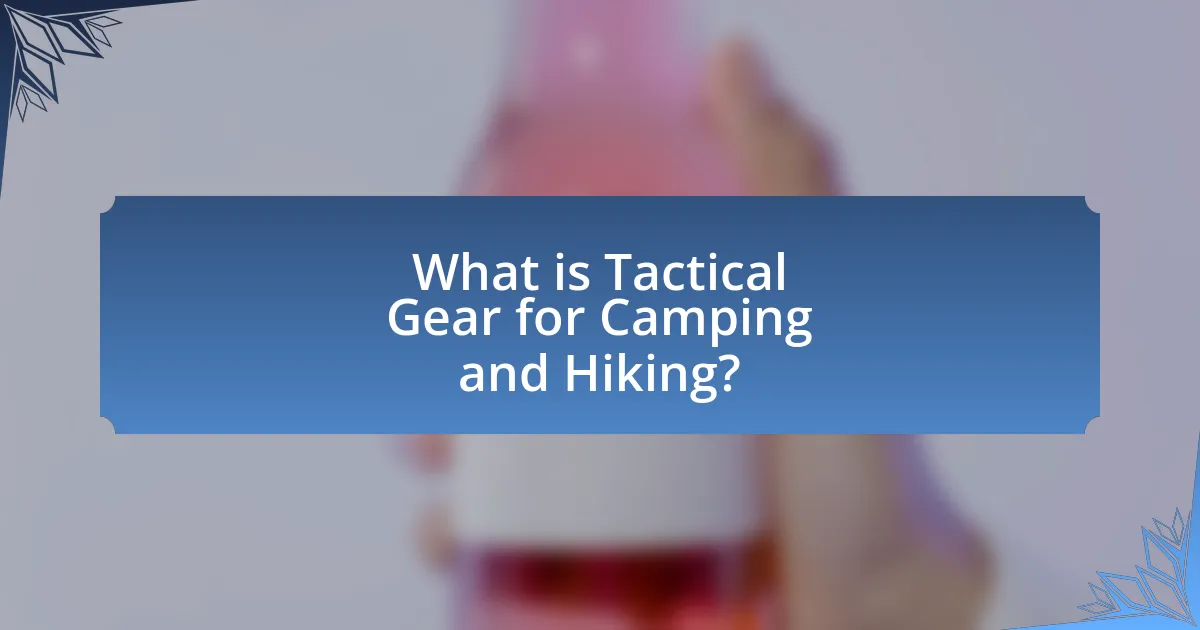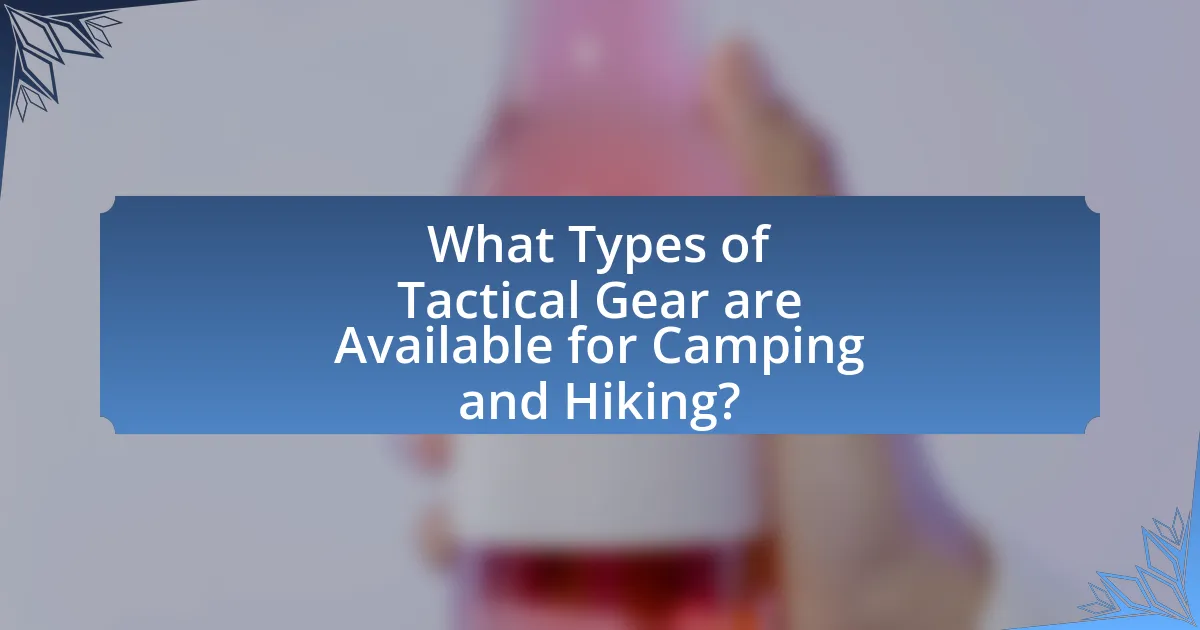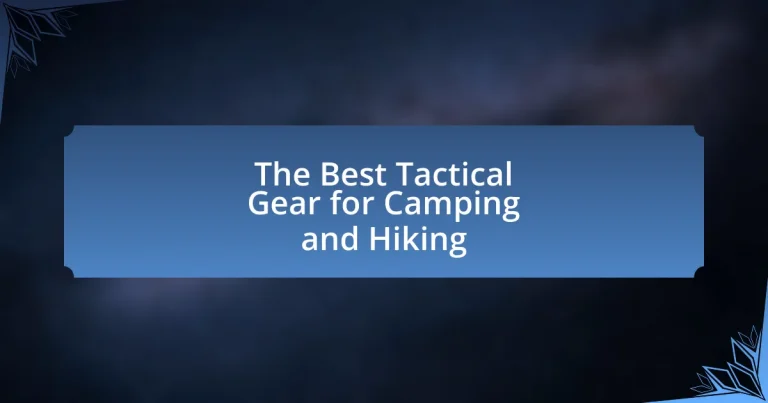The article focuses on the best tactical gear for camping and hiking, emphasizing specialized equipment designed to enhance safety, efficiency, and comfort during outdoor activities. It covers essential features of tactical gear, such as durability, versatility, and functionality, and explains how it differs from regular camping equipment. The article also highlights the importance of tactical gear for safety and efficiency, detailing various types available, including backpacks, tents, and clothing, while providing guidance on selecting the right gear based on activity level and personal needs. Additionally, it discusses maintenance tips and the significance of brand reputation in ensuring gear quality.

What is Tactical Gear for Camping and Hiking?
Tactical gear for camping and hiking refers to specialized equipment designed to enhance safety, efficiency, and comfort during outdoor activities. This type of gear typically includes items such as durable backpacks, multi-tools, tactical clothing, and protective footwear, all engineered for rugged use and adverse conditions. The functionality of tactical gear is often supported by features like water resistance, modular storage options, and reinforced materials, which are essential for outdoor survival and navigation. For instance, tactical backpacks often come with MOLLE (Modular Lightweight Load-carrying Equipment) systems, allowing users to customize their loadout based on specific needs.
How does tactical gear enhance outdoor experiences?
Tactical gear enhances outdoor experiences by providing durability, functionality, and versatility essential for various activities. This type of gear is designed to withstand harsh conditions, ensuring that users remain protected and comfortable during camping and hiking. For instance, tactical backpacks often feature multiple compartments and attachment points, allowing for organized storage and easy access to gear, which is crucial for efficiency in outdoor settings. Additionally, tactical clothing is made from moisture-wicking and breathable materials, which help regulate body temperature and improve comfort during physical exertion. The use of tactical gear can significantly improve safety and preparedness, as many items include features such as built-in first aid kits or emergency signaling devices, which can be vital in unexpected situations.
What are the essential features of tactical gear?
The essential features of tactical gear include durability, versatility, and functionality. Durability ensures that the gear can withstand harsh conditions, often made from high-quality materials like nylon or polyester that resist wear and tear. Versatility allows tactical gear to be used in various situations, such as camping, hiking, or emergency scenarios, often featuring modular designs that accommodate different accessories. Functionality is highlighted through practical features like multiple pockets for organization, adjustable straps for a secure fit, and weather-resistant properties to protect against the elements. These features collectively enhance the user experience and effectiveness in outdoor activities.
How does tactical gear differ from regular camping equipment?
Tactical gear differs from regular camping equipment primarily in its design and functionality, focusing on durability, versatility, and operational readiness. Tactical gear is often constructed from high-strength materials, such as nylon or polyester, which provide enhanced resistance to wear and tear compared to standard camping gear, which may prioritize comfort and lightweight features. Additionally, tactical gear typically includes modular components, such as MOLLE (Modular Lightweight Load-carrying Equipment) systems, allowing users to customize their loadout for specific missions or environments, whereas regular camping equipment is generally designed for more static, recreational use. This distinction is evident in the fact that tactical gear often incorporates features like reinforced stitching, water resistance, and specialized pockets for tools and weapons, which are not commonly found in traditional camping gear.
Why is tactical gear important for safety and efficiency?
Tactical gear is important for safety and efficiency because it enhances protection and functionality in outdoor activities. This type of gear is designed with durable materials and features that provide essential safety measures, such as weather resistance, impact protection, and visibility enhancements. For instance, tactical backpacks often include compartments for first aid kits and survival tools, which can be critical in emergencies. Additionally, the ergonomic design of tactical clothing allows for greater mobility and comfort, enabling users to perform tasks more efficiently. Studies have shown that using specialized gear can reduce injury rates and improve overall performance in outdoor settings, making it a vital component for camping and hiking activities.
What safety benefits does tactical gear provide?
Tactical gear provides enhanced safety benefits such as protection from environmental hazards, improved visibility, and increased durability. This type of gear often includes features like weather-resistant materials, which shield users from rain and extreme temperatures, and reflective elements that enhance visibility in low-light conditions. Additionally, tactical gear is designed to withstand wear and tear, ensuring that it remains functional and protective during rigorous outdoor activities. For instance, many tactical vests and jackets are made from high-denier nylon, which is known for its strength and resistance to abrasions, thereby reducing the risk of injury in rugged terrains.
How does tactical gear improve efficiency during outdoor activities?
Tactical gear improves efficiency during outdoor activities by providing specialized features that enhance performance and safety. For instance, tactical backpacks are designed with multiple compartments for organized storage, allowing users to access gear quickly without wasting time. Additionally, tactical clothing often incorporates moisture-wicking and durable materials, which help regulate body temperature and withstand harsh conditions, thereby increasing comfort and mobility. Research indicates that well-designed tactical gear can reduce fatigue and improve overall effectiveness in outdoor environments, as evidenced by studies showing that users equipped with appropriate gear can cover greater distances with less effort.

What Types of Tactical Gear are Available for Camping and Hiking?
Tactical gear available for camping and hiking includes backpacks, tents, sleeping bags, clothing, and multi-tools. Backpacks designed for tactical use often feature modular attachment systems and durable materials, enhancing storage and organization for outdoor activities. Tents in this category are typically lightweight, weather-resistant, and easy to set up, providing reliable shelter. Sleeping bags are designed for various temperature ranges, ensuring comfort during overnight trips. Tactical clothing, such as moisture-wicking shirts and durable pants, offers protection and functionality. Multi-tools combine various tools into one compact device, making them essential for a range of tasks in the field. This gear is specifically designed to withstand the rigors of outdoor environments, ensuring reliability and performance.
What are the most common types of tactical gear used?
The most common types of tactical gear used include tactical backpacks, tactical vests, tactical boots, and tactical belts. Tactical backpacks are designed for durability and organization, often featuring multiple compartments for gear storage. Tactical vests provide additional storage and quick access to essential items, while tactical boots offer support and traction for various terrains. Tactical belts are used to secure gear and equipment, ensuring easy access during outdoor activities. These gear types are widely recognized for their functionality and reliability in camping and hiking scenarios.
How do tactical backpacks differ from standard backpacks?
Tactical backpacks differ from standard backpacks primarily in their design and functionality, emphasizing durability, organization, and versatility for outdoor and tactical use. Tactical backpacks are constructed from high-denier nylon or polyester, making them more resistant to wear and tear compared to standard backpacks, which often use lighter materials. Additionally, tactical backpacks feature modular attachment systems, such as MOLLE (Modular Lightweight Load-carrying Equipment), allowing users to customize their storage options with pouches and gear, a feature typically absent in standard backpacks. Furthermore, tactical backpacks often include specialized compartments for carrying tools, hydration systems, and other tactical gear, enhancing their utility for specific activities like camping and hiking.
What features should a tactical tent have?
A tactical tent should have durability, weather resistance, portability, and ease of setup. Durability is essential for withstanding harsh conditions, often achieved through high-quality materials like ripstop nylon or polyester. Weather resistance ensures protection against rain, wind, and UV rays, typically provided by waterproof coatings and strong seams. Portability is crucial for ease of transport, often facilitated by lightweight designs and compact storage options. Finally, ease of setup is important for quick deployment in various environments, often enhanced by color-coded poles and intuitive designs. These features collectively ensure that a tactical tent meets the demands of outdoor activities effectively.
What specialized tactical gear should you consider?
When considering specialized tactical gear for camping and hiking, essential items include tactical backpacks, multi-tools, and tactical clothing. Tactical backpacks are designed for durability and organization, often featuring multiple compartments and MOLLE webbing for attaching additional gear. Multi-tools provide versatility, combining several tools into one compact device, which is crucial for various tasks in the field. Tactical clothing, made from moisture-wicking and durable materials, offers comfort and protection against the elements. These gear choices enhance functionality and safety during outdoor activities, making them vital for effective camping and hiking experiences.
How do tactical clothing options enhance performance?
Tactical clothing options enhance performance by providing durability, flexibility, and functionality tailored for outdoor activities. These garments are often made from high-performance materials that resist wear and tear, ensuring longevity in rugged environments. Additionally, tactical clothing typically features moisture-wicking properties, which help regulate body temperature and keep the wearer dry during physical exertion. For instance, many tactical shirts and pants incorporate reinforced stitching and multiple pockets for easy access to essential gear, thereby improving efficiency and convenience while camping or hiking. The design of tactical clothing also allows for a greater range of motion, which is crucial for activities that require agility and quick movements.
What role do tactical footwear play in outdoor activities?
Tactical footwear plays a crucial role in outdoor activities by providing durability, support, and traction essential for various terrains. These specialized shoes are designed to withstand harsh conditions, ensuring that users can navigate rugged landscapes safely. For instance, tactical boots often feature reinforced toe caps and waterproof materials, which enhance protection against environmental hazards. Additionally, the soles of tactical footwear typically incorporate advanced grip technologies, allowing for better stability on slippery or uneven surfaces. This combination of features not only improves performance but also reduces the risk of injuries during outdoor pursuits.

How to Choose the Best Tactical Gear for Your Needs?
To choose the best tactical gear for your needs, first assess the specific activities you will engage in, such as camping or hiking, as different scenarios require different gear. For instance, if you plan to hike in rugged terrain, prioritize durable footwear and weather-resistant clothing. Additionally, consider the weight and portability of the gear, as lightweight options enhance mobility during long treks. Research reputable brands known for quality and reliability, such as 5.11 Tactical or Condor Outdoor, which have established a strong reputation in the tactical gear market. Furthermore, read reviews and seek recommendations from experienced users to ensure the gear meets your performance expectations and safety standards.
What factors should you consider when selecting tactical gear?
When selecting tactical gear, consider durability, functionality, comfort, and weight. Durability ensures that the gear can withstand harsh conditions, which is crucial for camping and hiking. Functionality relates to the gear’s ability to meet specific needs, such as storage capacity and accessibility. Comfort is essential for prolonged use, as it affects mobility and overall experience. Weight impacts how easily you can carry the gear over long distances, influencing your endurance and efficiency. These factors collectively enhance the effectiveness and enjoyment of outdoor activities.
How does your activity level influence gear selection?
Your activity level directly influences gear selection by determining the type and intensity of equipment needed for optimal performance and safety. For instance, high-intensity activities like mountain climbing require specialized gear such as climbing harnesses and carabiners, while moderate activities like hiking may only necessitate durable footwear and a daypack. Research indicates that using appropriate gear based on activity level can enhance safety and comfort; for example, a study published in the Journal of Outdoor Recreation and Tourism highlights that participants using gear suited to their activity level reported fewer injuries and greater satisfaction during outdoor activities.
What is the importance of fit and comfort in tactical gear?
Fit and comfort in tactical gear are crucial for optimal performance and safety during outdoor activities. Properly fitting gear allows for unrestricted movement, which is essential for tasks that require agility and quick responses, such as hiking or camping in challenging environments. Comfort reduces fatigue, enabling users to maintain focus and endurance over extended periods. Research indicates that discomfort can lead to distractions and decreased effectiveness, highlighting the need for well-designed gear that accommodates various body types and activities. For instance, studies show that ill-fitting footwear can cause blisters and injuries, directly impacting a person’s ability to navigate rugged terrain. Therefore, prioritizing fit and comfort in tactical gear enhances overall functionality and user experience.
What are the top brands known for tactical gear?
The top brands known for tactical gear include 5.11 Tactical, Condor Outdoor, Blackhawk, and Tactical Tailor. These brands are recognized for their high-quality materials, innovative designs, and extensive product ranges that cater to military, law enforcement, and outdoor enthusiasts. For instance, 5.11 Tactical is renowned for its durable clothing and gear, often used by professionals in demanding environments. Condor Outdoor offers a wide variety of tactical vests and backpacks, while Blackhawk is known for its tactical holsters and accessories. Tactical Tailor specializes in custom gear solutions, emphasizing functionality and durability.
How do brand reputations affect gear quality?
Brand reputations significantly influence gear quality by establishing consumer trust and expectations. When a brand is well-regarded, it often invests in higher-quality materials and manufacturing processes to maintain its reputation, leading to superior gear performance and durability. For instance, brands like Patagonia and The North Face are known for their commitment to quality and sustainability, which is reflected in their products’ longevity and reliability in outdoor conditions. Studies have shown that consumers are willing to pay a premium for products from reputable brands, reinforcing the idea that brand reputation directly correlates with perceived and actual gear quality.
What should you look for in customer reviews of tactical gear?
In customer reviews of tactical gear, you should look for durability, functionality, and comfort. Durability indicates how well the gear withstands wear and tear, which is crucial for outdoor activities. Functionality refers to the gear’s practical features, such as pockets, straps, and ease of use, which enhance the user experience. Comfort is essential for prolonged use, especially during camping and hiking. Reviews that highlight these aspects often provide insights into real-world performance, helping potential buyers make informed decisions. For instance, a review mentioning that a backpack survived harsh weather conditions and remained comfortable during a long hike reinforces the importance of these factors.
What are some tips for maintaining your tactical gear?
To maintain your tactical gear effectively, regularly clean and inspect it for wear and tear. Cleaning involves using mild soap and water to remove dirt and debris, while inspections should focus on checking for frayed straps, broken zippers, and any signs of damage. Additionally, store your gear in a cool, dry place to prevent mold and mildew, and apply appropriate waterproofing treatments to maintain its functionality in wet conditions. These practices are essential as they prolong the lifespan of tactical gear, ensuring it remains reliable during camping and hiking activities.
How can proper cleaning extend the life of your gear?
Proper cleaning can significantly extend the life of your gear by removing dirt, grime, and corrosive substances that can cause wear and tear. Regular maintenance prevents the buildup of materials that can degrade fabrics and components, ensuring that zippers, seams, and waterproofing remain intact. For instance, a study by the American Society for Testing and Materials found that regular cleaning of outdoor gear can enhance its durability by up to 30%, as it reduces the risk of mold and mildew, which can compromise structural integrity.
What storage practices help preserve tactical equipment?
Proper storage practices that help preserve tactical equipment include keeping items in a cool, dry environment, using protective cases, and regularly inspecting gear for wear and tear. A cool, dry environment prevents moisture buildup, which can lead to rust or mold, while protective cases shield equipment from physical damage and environmental factors. Regular inspections allow for early detection of any issues, ensuring that equipment remains functional and safe for use. These practices are supported by industry standards that emphasize the importance of environmental control and maintenance in prolonging the lifespan of tactical gear.


